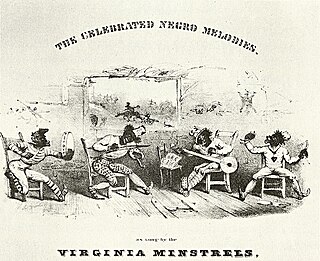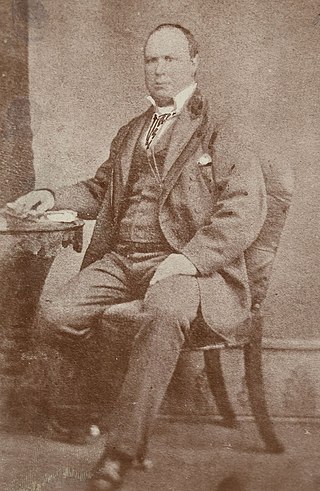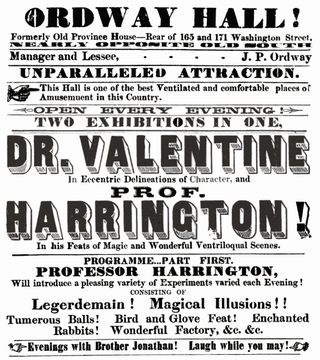
The minstrel show, also called minstrelsy, was an American form of racist theatrical entertainment developed in the early 19th century. Each show consisted of comic skits, variety acts, dancing, and music performances that depicted people specifically of African descent. The shows were performed by mostly white people wearing blackface make-up for the purpose of playing the role of black people. There were also some African-American performers and black-only minstrel groups that formed and toured. Minstrel shows caricatured black people as dim-witted, lazy, buffoonish, cowardly, superstitious, and happy-go-lucky.

Sam Lucas was an American actor, comedian, singer, and songwriter. Sam Lucas's exact date of birth is disputed. Lucas's year of birth, to freed former slaves, has also been cited as 1839, 1841, 1848 and 1850.

The Handel and Haydn Society is an American chorus and period instrument orchestra based in Boston, Massachusetts. Known colloquially as 'H+H', the organization has been in continual performance since its founding in 1815, the longest-serving such performing arts organization in the United States.

Richard Ward "Dick" Pelham, born Richard Ward Pell, was an American blackface performer. He was born in New York City.

The Chatham Theatre or Chatham Street Theatre was a playhouse on the southeast side of Chatham Street in New York City. It was located at numbers 143-9, between Roosevelt and James streets, a few blocks south of the Bowery. At its opening in 1839, the Chatham was a neighborhood establishment, which featured big-name actors and drama. By the mid-1840s, it had become primarily a venue for blackface minstrel shows. Frank S. Chanfrau restored some of its grandeur in 1848.

The Boston Music Hall was a concert hall located on Winter Street in Boston, Massachusetts, with an additional entrance on Hamilton Place.

Benjamin Johnson Lang was an American conductor, pianist, organist, teacher and composer. He introduced a large amount of music to American audiences, including the world premiere of Pyotr Ilyich Tchaikovsky's Piano Concerto No. 1, which he conducted in Boston in 1875.

The Flag of Our Union (est.1846) was a weekly story paper published in Boston, Massachusetts, in the mid-19th century. In addition to news it featured works of fiction and poetry including contributions from notable writers such as Louisa May Alcott and Edgar Allan Poe. Publisher Frederick Gleason began The Flag in 1846, a "miscellaneous family journal, containing news, wit, humor, and romance -- independent of party or sect." Original stories, verse, and illustration appeared in the paper, as well as brief news items on local, national and international current events. Maturin Murray Ballou served as editor. In 1849, Gleason's office was located "on the corner of Court and Tremont Streets" in Boston.

The Boston Museum (1841–1903), also called the Boston Museum and Gallery of Fine Arts, was a theatre, wax museum, natural history museum, zoo, and art museum in 19th-century Boston, Massachusetts. Moses Kimball established the enterprise in 1841.

The Concert Hall (1752–1869) was a performance and meeting space in Boston, Massachusetts, located at Hanover Street and Queen Street. Meetings, dinners, concerts, and other cultural events took place in the hall.
Samuel Hale Parker (1781–1864) was a publisher and bookseller in 19th-century Boston, Massachusetts, United States. He published musical scores as well as novels, sermons, and other titles. He operated the Boston Circulating Library, and was among the founders of the Handel and Haydn Society.
Amory Hall was located on the corner of Washington Street and West Street in Boston, Massachusetts, in the 19th century. Myriad activities took place in the rental hall, including sermons; lectures by Henry David Thoreau, Ralph Waldo Emerson, William Lloyd Garrison; political meetings; exhibitions by Rembrandt Peale, George Catlin, John Banvard; moving panoramas; magic shows; concerts; and curiosities such as the "Nova Scotia Giant Boy."

Charles T. "Charlie" or "Charley" White (1821–1891), was an early blackface minstrel entertainer.

Ordway Hall (est.1852) was a theatre in Boston, Massachusetts located off Washington Street in the former Province House. John P. Ordway established and managed the hall, which specialized in "negro minstrelsy," particularly the Ordway Aeolians, his own troupe.

The Temple School, in Boston, Massachusetts, USA, was established by Amos Bronson Alcott and Elizabeth Palmer Peabody in 1834, and featured a teaching style based on conversation. Teachers working at the school included Elizabeth Peabody and Margaret Fuller.

Johann Christian Gottlieb Graupner was a musician, composer, conductor, educator and publisher. Born in Hanover, Germany, he played oboe in Joseph Haydn's orchestra in London. After moving to the United States in the 1790s, he co-founded the Philharmonic Society and the Handel and Haydn Society in Boston, Massachusetts.

The Germania Musical Society (1848–1854) was an orchestra that performed in the United States in the mid-19th century. Its musicians emigrated from Germany after a successful tour of England. Carl Lenschow and Carl Bergmann served as directors. The group toured throughout the country. Concerts took place in the Melodeon and the Music Hall, Boston; Brinley Hall and City Hall, Worcester, Massachusetts; Astor Opera House, New York City; Metropolitan Hall, New York City; Ocean Hall, Newport, Rhode Island; Westminster Hall, Providence; and elsewhere.

The National Theatre (1836-1863) was a theatre in the West End of Boston, Massachusetts, in the mid-19th century. William Pelby established the enterprise in 1836, and presented productions of "original pieces, and the efforts of a well selected stock company, which, with few exceptions, have been American. The scenery is of the highest order, and the business of the stage well directed. Mr C.A. Eaton made his debut at this theatre, and here Mr. F.S. Hill's early labors were eminently successful. Mr. J.S. Jones has written and produced on this stage thirty pieces, embracing every department except tragedy." William Washburn designed the building, erected on the site of the former Warren Theatre. Performers at the National included Edwin Adams, Marietta Zanfretta, Jean Margaret Davenport, Julia Dean, Jonathan Harrington, W.H. Smith, Mary Ann Vincent, and Billy Whitlock. In 1852 the theatre burnt down, and was rebuilt. In 1863 the building was again destroyed by fire.

The Odeon of Boston, Massachusetts, was a lecture and concert hall on Federal Street in the building also known as the Boston Theatre. The 1,300-seat auditorium measured "50 feet square" with "red moreen"-upholstered "seats arranged in a circular order, and above them ... spacious galleries." The Boston Academy of Music occupied the Odeon in the 1830s and 1840s Notable events at the Odeon included "the first performance in Boston of a Beethoven symphony."
John Edward Goodson was a 19th-century North American classical music educator, performer, composer, and conductor. Goodson, a highly skilled pianist and organist, was born and raised in London, England, and received his early education at the St. Paul's Cathedral School. The son of a London shoemaker, he fled the cholera epidemic of 1832–33 and emigrated to York, Upper Canada. After immigrating to the United States, he met Ralph Waldo Emerson while living and teaching music in Cincinnati, and was eventually lured to Boston by Emerson for a brief time. It was during this time that Goodson became the conductor of the Handel and Haydn Society. He was also mentioned in Emerson's notes about forming a "Boston Club" along with Nathaniel Hawthorne and Bronson Alcott. After leaving Boston in 1852, he lived out most of the remainder of his days in St. Louis, Missouri, continuing to teach music and also continuing to write and perform publicly. While unproven, it has been passed down within the family that Goodson was a direct descendant of Vice-Admiral William Goodson, one of Oliver Cromwell's Admirals during the Protectorate. It is quite possible that the memoirs of his Grandfather, William Goodson of Waddesdon, Buckinghamshire, may shed some more light on it.






















